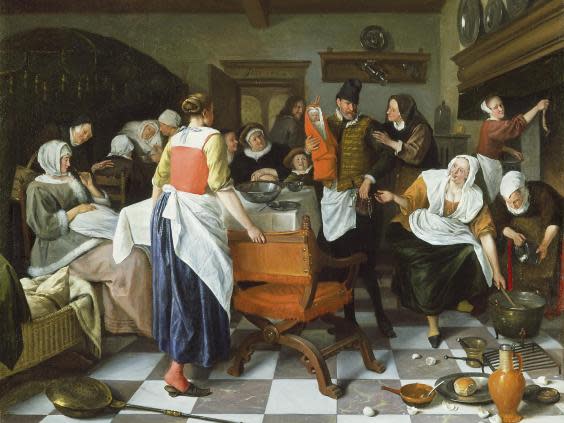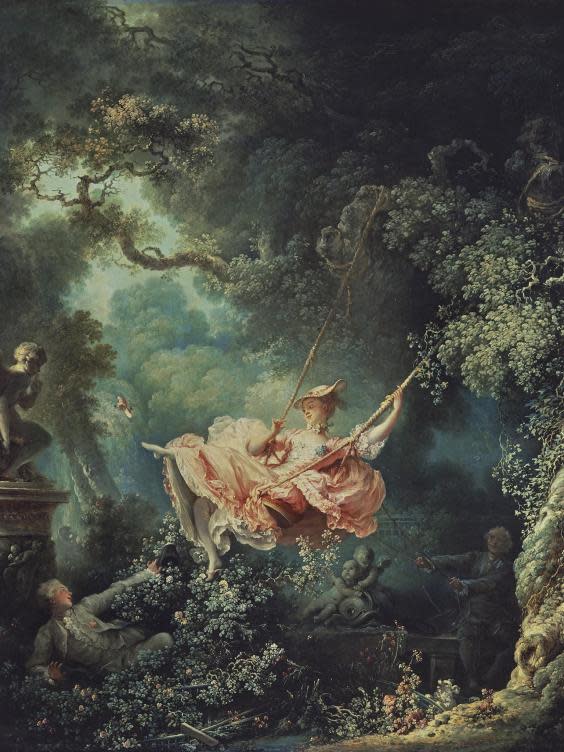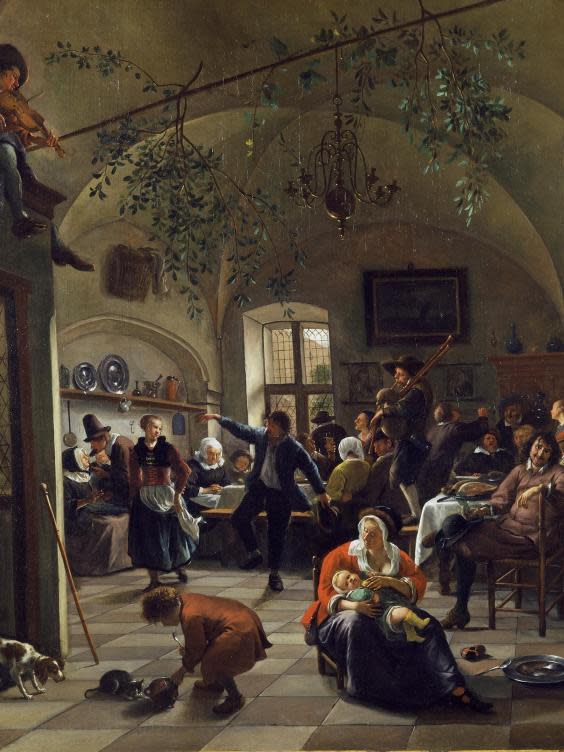Why is the Laughing Cavalier, who is neither a cavalier nor laughing, looking so pleased with himself?
What is the meaning of a sausage? Until the other day, I had no idea that a sausage even had any meaning (unless, that is, you happen to be ravenously hungry). Imagine the surprise, therefore, of the conservators in London who, back in 1983, were sprucing up a classic painting by the 17th-century Dutch master Jan Steen, when they discovered a lost sausage. Or rather not so much lost as “disappeared”.
You can see that painting, Celebrating the Birth, in all its domestic glory, in the wonderful Wallace Collection in Manchester Square, just off Oxford Street. But prior to 1983 you would not have seen the sausage, or indeed the hand of the long-haired artist himself, about to go out of the door at the back of the kitchen, holding two fingers over the head of the babe. Painting “cleaners” (or conservators) are sometimes like detectives carefully inspecting the scene of a crime. In this case their research took them back to the Victorian period when the works of Shakespeare could be re-written for the purpose of making more of a happy ending – and when the statue of a naked David in the V&A could have a fig-leaf applied to the relevant parts on the occasion of a visit from Queen Victoria.
Probably sometime in the 1850s, a skilful painter had been employed to paint over (rather as you might use software today to remove undesirable elements from your favourite holiday snap) the offending sausage and the two-fingered salute – originally dating from 1664 (the year is spelt out in the painting itself). But what was the big deal about the sausage anyway? How could hypersensitive Victorian morality be offended by the depiction thereof?
I had the advantage of being accompanied by the very knowledgeable Anne Fay, head of education at the Wallace Collection, but you can work it all out for yourself just by looking very intently at the restored painting, now hanging in East Gallery II. In Holland you can still talk about a “Jan Steen” household or room. But the phrase isn’t necessarily complimentary. It doesn’t mean “beautiful” or “artistic”, but rather “chaotic” or “messy”. “Celebrating the birth” depicts a busy, bustling kitchen scene or “lying-in room”.
There are 16 people crowded into the room (counting the babe), with a lot of cooking going on around the fireplace. In the foreground, lying on the floor are several broken eggshells together with pots of what looks like maple syrup and a roll on a plate. A buxom cook is leaning over a cooking pot mixing some kind of brew with a ladle and holding out her other hand for payment.
The sausage (or, technically, a string of sausages) is hanging down from above the fireplace, attached to the chimney. It is long and rather limp-looking and probably deserves the word, “dangling”. A maid is handling it, looking out of the picture directly towards the spectator, with an expression that might be roguish. But what does it mean and why would you want to paint it over? People ate sausages back then, didn’t they? Why would you not have one in a kitchen?
The sausage, you will have guessed, is susceptible to a phallic reading. The prudish Victorians thought so. It could be mistaken for the same sexual organ the David fig-leaf was designed to conceal. And a long but rather flaccid one at that. But, as Freud may have said, sometimes a cigar is just a cigar. And isn’t a sausage sometimes nothing more than a traditional form of fast food? But now combine the sausage with the image of the painter holding up two fingers over the head of the father figure.
Is this an obscene gesture? Only in the sense that the two fingers are meant to represent horns and thus signify “cuckold”. The painter, in other words, is suggesting – every father’s nightmare – that the father is not in fact the father. His wife is cheating on him. So we look carefully at the nominal father, who is holding the child in one arm and reaching into his pouch with his other hand (probably to pay the midwife). He has a grey beard and an apron, and is no spring chicken. Combined with the limp sausage, the implication is that the ageing man could be impotent and incapable of fathering a child.

Who then is the father? And we should remember that there is a pregnant woman in the kitchen, sitting comfortably on the left of the scene, sipping a drink, looking rather beatific (possibly sozzled too). The leading candidate for rogue inseminator is the painter himself. Rather like Alfred Hitchcock making a brief appearance in one of his own movies, Jan Steen would often paint himself into the picture. And if he is making a point here, it is less an assertion of his own sexual prowess than the subtle reminder that indeed he and no other has given birth to every single one of the figures depicted in the painting. The two fingers are like a Steen signature, saying: “I am the artist.”
The Wallace Collection is one of the nation’s great treasures but modest in scope by comparison with some of our better-known museums. And it’s housed in a building, Hertford House, that doesn’t look much like a museum either. It was originally a hunting lodge when it was built in the 18th century, with a curving driveway in front. You might not even notice it, tucked away as it is behind Selfridge’s. But the whole collection is an exercise is being more alert and noticing stuff you might not otherwise notice or know about. For example, until I had a good look at a gorgeous ancien régime chest of drawers that once adorned Versailles, I had no idea that the chest of drawers (or “commode”) was an 18th-century invention. I have no idea where they used to put their socks and smalls before then.
My guide Anne Fay helpfully explained that the word “Rococo” comes from the French rocaille, meaning rocky ground or rockery, and containing elaborate references to natural configurations such as shells and pebbles. But she also directed me towards a small but bewitching painting, The Swing by the French painter Jean-Honoré Fragonard (dated 1767). The central figure in this work is a pure Disney princess at first glance. The girl on the swing – or let’s say, young woman, aged perhaps 18 at most – is radiant. She seems to generate light or, to turn it around, the spotlight is all on her. She looks ecstatic and her peachy, lacey, frilly dress similarly emanates a kind of joie de vivre. Even her bergère hat is jaunty.

But again, if you look carefully, there are elements in this painting that Disney, while borrowing the wardrobe, would surely prohibit. One of the girl’s dainty shoes is flying up through the air. Lying on the ground, to the left of the painting, underneath the swing, is a young man, his hat in his hand, a flower in his buttonhole, his face illuminated by the light of the girl. He too looks delighted. His gaze is directed towards the girl. But if we follow his gaze carefully we can see that he is looking right up into her dress, which is billowing open as she kicks her legs. We see a flash of bare thigh, she may or may not be wearing any underwear, we do not know. But there is a liberated, playful quality to the girl that suggests possibly not. Without any actual cameras, the painting gives us a classic scene of upskirting. But, so far as we can judge, consensual. The girl and the young man may well be lovers.
But as you might expect there is a love triangle here. Look to the right of the painting and you will see, almost hidden in the shadows, a much older man, who is pulling the ropes attached to the swing – perhaps trying to pull the girl back to him. Who is he? Probably the husband. Also, quite possibly – as in the Steen painting – cuckolded, displaced in the marital bed by the younger man (who is, after all, already lying down and is being given a privileged through-the-keyhole glimpse of what is typically concealed).
The girl on the swing looks entirely carefree. She is having a great time. She may be making some mocking gesture to do with her husband. But there are subtle hints in the painting that not all is well. For one thing, if you look carefully, the ropes that suspend the swing from some kind of grotto appear to be fraying. The swing itself may be unsafe. There are storm clouds gathering. The cupid figures dotted around the canvas are looking nervous. And finally, a little white-haired dog that you might not even notice, down on the right-hand side, is watching and barking. As if everything is about to go wrong. The painting is only a still, a snapshot, but it contains narratives, with alternative endings
But probably the single most famous painting in the whole of the collection is The Laughing Cavalier, by Franz Hals (1624). Of course the irony of this painting is that the subject is neither laughing nor is he a cavalier. But he does look almost absurdly pleased with himself. He is smiling broadly and even his bristling handlebar moustache is smiling. He has rosy cheeks, curly hair, bright eyes, and is in blooming health. There are unproven theories as to who he is or was precisely. But none of that really matters. The laughing cavalier is a hyper-realistic image of vivacity, brimming over with good will and pleasure and, perhaps, anticipation.
Because, as in the Fragonard, there is a suggestion of a sexual encounter to come. Is he perhaps a bridegroom looking forward to his wedding night? Or is he on his way to meet his secret lover? His richly detailed garb implies as much. The embroidered sleeve of his silk tunic (with no less than nine buttons on the cuff) is decorated with any number of symbols suggestive of a carnal union: Cupid’s arrows and lovers’ knots. But we also have a flaming cornucopia and a bee – connoting honey and sweetness but also, potentially, a sting.
So Hals is being rather poised and ambiguous here. The laughing cavalier is rather like the girl on the swing, on a high, but he could conceivably come down with a bump if he’s not careful. We don’t know, we only have the immortal moment of hope and expectation. Which cannot be extinguished. But could be understood as over-optimistic. And yes, the eyes really do follow you around the room.

I live a 10-minute cycle ride away from the Wallace Collection. And yet I barely knew it was there until the other day. The Wallace Collection is due mainly to Sir Richard Wallace, who was probably the illegitimate son of the 4th Marquess of Hertford and is described in a new book by Suzanne Higgott as “the most fortunate man of his day”. His collection was bequeathed to the nation by his widow, Lady Wallace, in 1897. But she didn’t leave any endowment for the purposes of upkeep.
The museum, which is free to enter, now makes its living partly on the basis of retail and renting out its space. You can have a wedding party, Jan Steen-style, in the Grand Gallery for a cool £20,000. Or stage your corporate event there, in one of the most elegant settings in the country. Or just come for lunch or dinner in the courtyard café.
But the paintings and fine works that are exhibited there remind you of the importance of not just seeing but looking. As one of the parables (in Mark’s gospel) says, you can see and yet not perceive. One of the great lookers (in the sense of doing the looking rather than being looked at) was Henry Moore. An exhibition of his works is opening at the Wallace in March. Moore would sit here and get inspiration in the armoury. He could see helmets were not just function they were also form. The helmet morphs, in his hands, into a symbol of protection that embraces mother and child.
But what is the point of art anyway? Is it to reveal, in a Freudian way, the hidden pathways of the unconscious? To boast of the artist’s libido? One plausible evolutionary theory about the function of art maintains that it came about as an accessory to courting. A way of wooing or seducing. Come up and see my cave paintings some time. So therefore it’s not surprising if love triangles and other erotic geometries also get into the picture. But it can’t just be that surely.
For anyone brought up on Monet and Picasso, the Wallace Collection, with works that date largely from before the French Revolution, comes as a bit of a shock. The level of sheer realism, in some of those Dutch paintings, is dazzling. But there is a connection with modern painters even as abstract as, say, Mark Rothko (whose work is dramatised in the play Red). All those sustained blocks of colour, or Campbell’s soup cans (as painted by Warhol), are related to The Swing and The Laughing Cavalier by virtue of the infra-ordinary – all the stuff that we normally don’t notice. Works of art ask us to be more alert. To be better sensory beings. They are telling us to pay attention to the world. To take note of little things. Even if it’s only a sausage.
Andy Martin is the author of Reacher Said Nothing: Lee Child and the Making of Make Me. He teaches at the University of Cambridge.
The exhibition, “Henry Moore: The Helmet Heads”, runs at the Wallace Collection 6 March to 23 June. All images are courtesy of the Wallace Collection.
